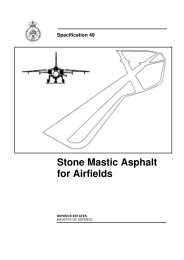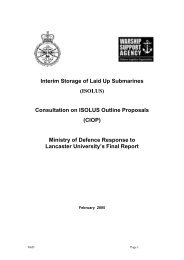Part III - Historical Survey of the Porton Down Service Volunteer ...
Part III - Historical Survey of the Porton Down Service Volunteer ...
Part III - Historical Survey of the Porton Down Service Volunteer ...
You also want an ePaper? Increase the reach of your titles
YUMPU automatically turns print PDFs into web optimized ePapers that Google loves.
minutes later one <strong>of</strong> <strong>the</strong> rabbits died. The experiment was brought to an abrupt end and <strong>the</strong><br />
men quickly washed <strong>of</strong>f <strong>the</strong> substance from <strong>the</strong>ir arms.<br />
On 14 April 1945, a meeting <strong>of</strong> <strong>the</strong> three UK <strong>Service</strong>s was convened at which it was decided<br />
that defensive measures against <strong>the</strong> new gas were to be developed urgently [12]. The<br />
foundation <strong>of</strong> <strong>the</strong> <strong>Service</strong>s' concern was that Germany might yet use <strong>the</strong> artillery shells<br />
against <strong>the</strong> Allies as more shells had been found at Espelkamp [13]. Telegrams [14] from <strong>the</strong><br />
War Office to <strong>the</strong> Headquarters <strong>of</strong> Allied Commands were sent on 16 April, containing<br />
preliminary information about GA [15], including:<br />
GA "is not a vesicant but is rapidly toxic if <strong>the</strong> eye or skin absorbs liquid - lethal dose<br />
for man <strong>of</strong> <strong>the</strong> order <strong>of</strong> 5 grams absorbed through skin. Vapour in low concentrations<br />
strongly constricts pupils and causes tightness <strong>of</strong> chest. Mainly dangerous in <strong>the</strong><br />
field to eyes and lungs as an initial cloud".<br />
The assessment <strong>of</strong> GA continued after <strong>the</strong>se telegrams were sent. Studies with animals and<br />
humans were conducted: on 18 April 1945 fifteen men, including <strong>Porton</strong> staff, were exposed<br />
to GA at levels <strong>of</strong> 3.2 mg.min/m 3 and 14 mg.min/m 3 (t = 2 mins) [15, 16]. The main results<br />
were:<br />
• pupils were constricted (miosis) by <strong>the</strong> lower dose, and this persisted for 48<br />
hours;<br />
• although all observers detected a faint smell at <strong>the</strong> higher dose, it was thought<br />
that <strong>the</strong> concentration (7mg/m 3 ) could not be reliably detected on <strong>the</strong> battlefield.<br />
At <strong>the</strong> higher dose all human subjects had "markedly constricted pupils" followed<br />
by a severe headache. These symptoms lasted for 2 days.<br />
PF-3 was known to cause miosis but exposures <strong>of</strong> between 40 and 80 mg.min/m 3 <strong>of</strong> PF-3<br />
were required to induce <strong>the</strong> same effects as <strong>the</strong> much lower doses <strong>of</strong> GA used here. It was<br />
thought important, <strong>the</strong>refore, to explore miosis fur<strong>the</strong>r and find out if it affected military<br />
efficiency [15].<br />
The study in July 1945 involved 42 <strong>Service</strong> volunteers. Seven men were exposed twice.<br />
Some men wore no protection during <strong>the</strong> study and were exposed to GA at 0.7-21 mg.min/m 3<br />
(t = 10 mins). Some men had <strong>the</strong>ir lungs protected by an oro-nasal respirator and were<br />
exposed to 30 mg.min/m 3 (t = 10 mins). The main results were as follows [17]:<br />
• <strong>the</strong> exposure to 0.7 mg.min/m 3 induced coughing and <strong>the</strong> feeling <strong>of</strong> constriction<br />
<strong>of</strong> <strong>the</strong> chest;<br />
• exposures to 14, 18 and 21 mg.min/m 3 had a "severe harassing effect"<br />
characterised by some or all <strong>of</strong> <strong>the</strong> following symptoms: severe headache,<br />
pinpoint constriction <strong>of</strong> <strong>the</strong> pupils, pain when focusing on objects close to <strong>the</strong> eye,<br />
slight blurring in vision, tightness in <strong>the</strong> chest and coughing, nausea and<br />
vomiting. Without treatment, <strong>the</strong>se symptoms became most debilitating 24-48<br />
hours after exposure;<br />
• 30 mg.min/m 3 exposed only to one eye decreased visual acuity markedly, and<br />
recovery was not complete until at least 17 days later.<br />
This work suggested that exposures to GA <strong>of</strong> greater than 14 mg.min/m 3 would impair military<br />
efficiency and, <strong>the</strong>refore, might be regarded as harassing doses [18] but no studies had<br />
explicitly assessed <strong>the</strong> ability <strong>of</strong> <strong>the</strong> men exposed to GA to conduct military tasks. The next<br />
study [18] sought to remedy that.<br />
Later in July 1945, infantrymen and civilian staff working at <strong>Porton</strong> were exposed to GA at<br />
28 mg.min/m 3 (t = 10 mins) and <strong>the</strong>n asked to perform tasks that were part <strong>of</strong> <strong>the</strong>ir normal<br />
duties. Twenty nine people participated in this trial. For <strong>the</strong> infantrymen, <strong>the</strong> tasks included<br />
standard tests <strong>of</strong> elementary infantry training (rifle firing on <strong>the</strong> range and <strong>the</strong> operation <strong>of</strong> a<br />
60









